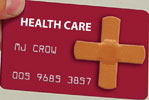

The evolution of a national health smartcard standard.
With the extensive press coverage that has been given to the planned National Health Insurance (NHI), naturally the issue of associated identification systems is being discussed by those in the trade. With this in mind, the South African Bureau of Standards (SABS) has been keenly developing a standard for the proposed smartcard which will be implemented along with the policy.
Speaking at the recent Cardex expo in Sandton, Tony Loxley and Cecilia Woker from SABS laid out some background info on just what goes into the establishment of a national standard.
Underlying principles of national standards
In summary, a standard is developed by technical committees based on consensus. To quote the SABS: “General agreement characterised by the absence of sustained opposition to substantial issues by any important part of the concerned interest, and by a process that involves seeking to take into account the views of all parties concerned and to reconcile any conflicting arguments” (Standards Act, Act No 8, 2008).
A couple of guidelines listed are:
* Standards may not present a technical barrier to trade (WTO agreement, annex 3).
* Standards may not be product-specific.
* Standards are developed by technical committees with balanced representation.
The specific standard developed for the smartcard is known as SANS 828, and is based on ISO21549, although it contains only two parts to the international standard’s six.
SANS 828
Some of the underlying principles pertaining to this standard in particular include the following:
* Every citizen registered in the national population register with a valid ID shall be entitled to a card.
* The card represents the cardholder in both public and private healthcare environments – ie, one’s NHI information, as well as one’s private medical aid details, will both be listed on the one card only.
* The card is intended to provide medical records from birth to death.
* The defined fields for each data object contained on the card shall be linked to electronic database(s) that contain at least a complete record of the data mirrored on the card.
* The card is intended to provide limited medical data on the card to improve the provision of treatment to the health cardholder and to provide the capability of operating in an offline environment.
* The identity of the cardholder shall be verified by reference to the national population register that contains authentic identification data of the health cardholder; and that is secured.
* Data shall be stored on the card so that the rights and ownership of the data held by the holder(s) of an applet shall be protected.
* Data on the card is held with a level of security that prevents free access.
* The HS card functions as a key that enables the health cardholder to give access to the health cardholder’s records.
Some of the reasoning behind selecting a smartcard as the preferred instrument is that “the complexity of the requirements needed for the health care environment requires the need for a smartcard application which is both multifunctional and multi-application”. Additionally, an offline capability was sought for emergency services and identification use. Additionally, data on the card needs to change. Finally, the security of the health-related data on the card is important.
International lessons
Speaking at Cardex, Noël Nader from SESAM-Vitale France gave the stakeholders an interesting review of what Europe has experienced and the lessons they have learned in dealing with their own smartcard systems across the continent.
Some of the European on-going debates and trends discussed can be summarised as follows:
Electronification of paper-based procedures is in the scope of many EU/EEA MS or third party countries. Intensive discussions about electronic portable documents are occurring, including those pertaining to:
* ID cards or Citizen multi-applications cards vs. smartcards devoted to a single service (eg health insurance).
* On-line access key (including digital signature/certificates and data encryption capabilities) vs. standalone embedded applications.
* Smart card technology vs. various tokens (eg USB keys, USB cards, dual SIM cards in mobile telephones, etc.).
Naturally these European debates and lessons learned save South Africa from having to experience all the trial and error that Europe has already been through and we can thus simply learn from their experience as we head down this digital path.
Article includes text quoted verbatim from the SABS presentation slides.

© Technews Publishing (Pty) Ltd. | All Rights Reserved.